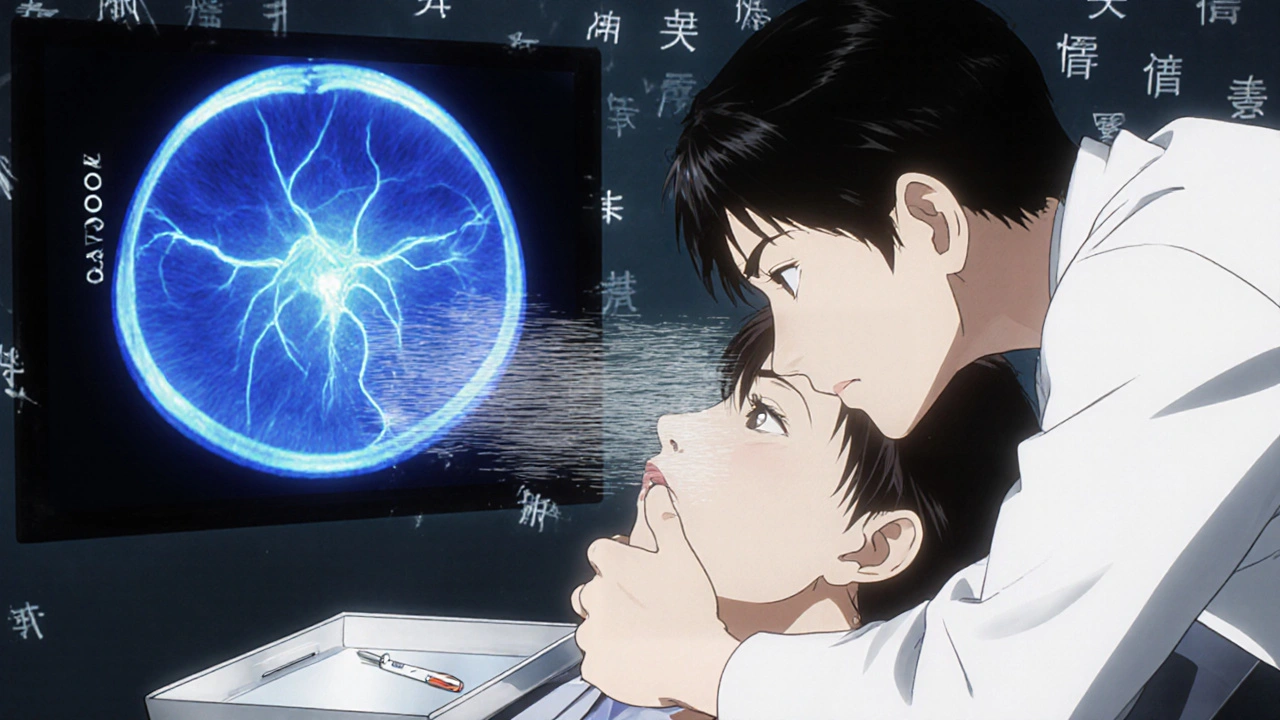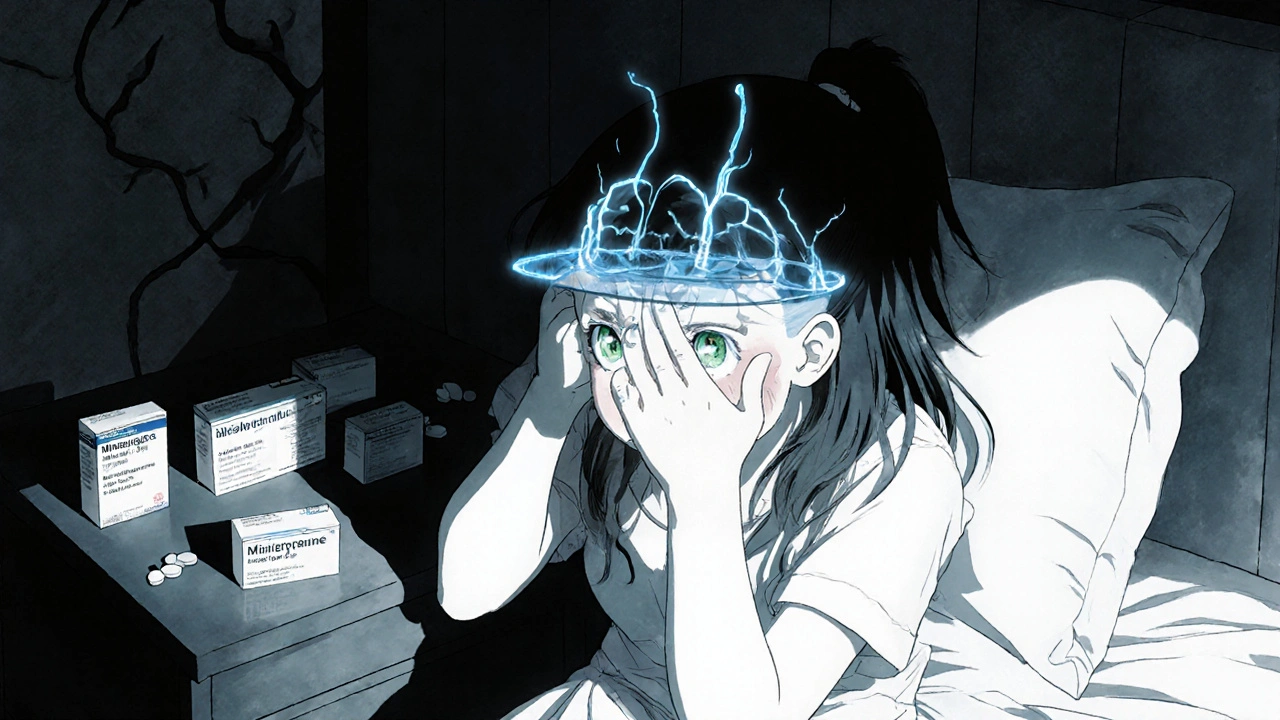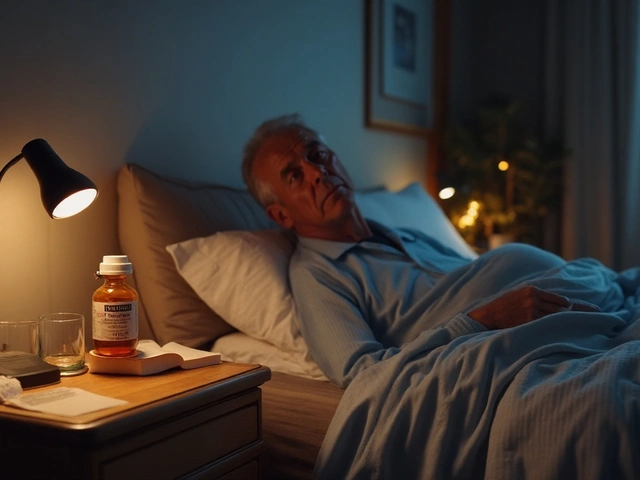Pseudotumor Cerebri Medication Risk Assessment Tool
This tool helps assess your risk of developing pseudotumor cerebri (idiopathic intracranial hypertension) based on medications you're taking. Pseudotumor cerebri can cause severe headaches and permanent vision loss if not detected early.
Medications You're Taking
Most common trigger in young adults. Risk increases after 1-6 months of use.
Vision changes can occur within 4-8 weeks. FDA requires monthly eye checks.
Stopping steroids too fast causes sudden pressure spikes. Risk of permanent vision loss up to 18%.
Can cause IIH in 8-12% of cases. Vision loss may occur before headaches start.
Less common trigger but possible.
Risk Assessment
Severe headaches that won’t go away. Vision that blurs for seconds at a time. Seeing shadows or gray spots when you look up or stand up. These aren’t just bad migraines or eye strain. They could be signs of pseudotumor cerebri - a dangerous condition triggered by certain medications. It’s not a tumor. But it acts like one. The pressure inside your skull rises, squeezing your optic nerves and causing pain that feels like a vice. And if it’s not caught fast, you could lose your vision - permanently.
What Exactly Is Pseudotumor Cerebri?
Pseudotumor cerebri, also called idiopathic intracranial hypertension (IIH), means your brain is under too much pressure - but there’s no tumor, no stroke, no infection causing it. The fluid around your brain, called cerebrospinal fluid (CSF), builds up and can’t drain properly. Normal CSF pressure is between 70 and 180 mm H₂O. In pseudotumor cerebri, it spikes above 250 mm H₂O. That’s like having a water balloon inside your skull that’s been overinflated.
The name comes from the fact that symptoms - constant headaches, vision problems, ringing in the ears - look exactly like those of a brain tumor. But scans show nothing abnormal. The real danger isn’t the headache. It’s the swelling at the back of your optic nerve, called papilledema. That’s what damages your sight. And once the nerve is injured, the damage can be irreversible.
Medications That Can Trigger It
While most cases of IIH are labeled "idiopathic," about 10 to 15% are directly caused by drugs. These aren’t rare side effects. They’re well-documented, predictable reactions - and many doctors still miss them.
- Minocycline (a type of tetracycline antibiotic): Used for acne, rosacea, and sometimes Lyme disease. It’s the most common medication trigger in young adults. One case occurs for every 7,500 prescriptions. Symptoms usually show up after 1 to 6 months of use.
- Isotretinoin (Accutane): A powerful acne drug. About 15 to 20% of medication-induced cases come from this. Vision changes can hit within 4 to 8 weeks. The FDA requires monthly eye checks for patients on this drug - but many patients aren’t told why.
- Corticosteroid withdrawal: Stopping prednisone or similar drugs too fast can cause a sudden spike in pressure. This is especially risky in people who’ve been on steroids for months. Vision loss is more common here than with other triggers - up to 18% of cases end in permanent damage.
- Growth hormone therapy: Used in children with growth disorders. In about 8 to 12% of cases, it causes IIH. The scary part? Kids may lose vision before they even feel a headache.
- Excess vitamin A: High-dose supplements or foods like liver can trigger it. Not common, but possible.
Here’s what’s worse: taking two of these at once. Using minocycline and isotretinoin together increases your risk by more than seven times. That’s not rare. It’s happening - especially in teens with severe acne who get both drugs prescribed at the same time.
How It Feels: Real Symptoms
People don’t just get "headaches." They get thunderclap headaches - sudden, crushing pain that gets worse when lying down, bending over, or coughing. Many describe it as "the worst headache of my life."
Vision changes are the red flag:
- Transient visual obscurations: Your vision goes gray or black for 5 to 15 seconds, often when standing up or looking up.
- Blurred or double vision: Especially in the morning.
- Peripheral vision loss: You stop seeing things out of the corner of your eye.
- Pulsatile tinnitus: A whooshing sound in your ears that matches your heartbeat.
One patient on a support forum wrote: "I thought I was going crazy. Every time I stood up, my vision turned to static. I went to three doctors. Two said it was stress. The third finally did a spinal tap - and found pressure at 310 mm H₂O. I was 22. I’d been on minocycline for 5 months."
Another shared: "I stopped Accutane after my vision got blurry. But my ophthalmologist missed the swelling for three months. Now I can’t see the road on my left side. It’s permanent."

Why Doctors Miss It
Over 65% of primary care doctors first diagnose this as migraine, sinus infection, or stress. Why?
- The symptoms mimic common problems.
- There’s no simple blood test.
- Medication use happened weeks or months ago - so the link isn’t obvious.
- Patients don’t connect the dots. They don’t tell their doctor they’re on minocycline or Accutane.
A 2022 study found that 41% of patients were told their headaches were "stress-related." Another 33% were diagnosed with migraines. The average delay in diagnosis? 4 to 12 weeks. That’s enough time for permanent vision damage to occur.
How It’s Diagnosed
If you’re on one of these meds and have new, severe headaches or vision changes, you need to act fast. Here’s what your doctor should do:
- Stop the suspected medication immediately - don’t wait for test results.
- Perform a lumbar puncture (spinal tap) within 72 hours. This measures CSF pressure. Anything above 250 mm H₂O confirms it.
- Do an eye exam with an ophthalmologist. Look for papilledema - swelling of the optic nerve.
- Get a visual field test (Humphrey perimetry). Early signs show up as missing spots in your upper nasal vision.
- Use optical coherence tomography (OCT). It measures the thickness of the nerve layer around your optic nerve. A rise of 15-20 microns in the first week is a key early sign.
Don’t rely on MRI or CT scans alone. They’ll likely look normal. The diagnosis isn’t about what you see on the scan - it’s about what you find in the fluid and the eye.
What Happens After Diagnosis
The good news? If caught early, medication-induced pseudotumor cerebri often reverses.
- Stopping the drug leads to improvement in 80% of cases within 4 to 12 weeks.
- Medications like acetazolamide or the newer venglustat help reduce fluid production and lower pressure.
- Weight loss helps in some cases - but not all. Unlike idiopathic IIH, this isn’t always tied to obesity.
- Severe cases may need surgery to relieve pressure, like a shunt or optic nerve sheath fenestration.
But here’s the hard truth: if you wait too long, the damage is done. Up to 10% of untreated cases result in permanent vision loss. And with corticosteroid withdrawal, that number jumps to nearly 20%.

Who’s at Risk - And Who Should Be Watched
It’s not just about age or gender. It’s about exposure.
- Women aged 15-25 on minocycline: Highest risk group. 85% of minocycline cases are in this group.
- Teens on isotretinoin: Especially if they’re also on antibiotics.
- Children on growth hormone: Vision loss can happen before headaches start.
- Anyone stopping steroids after long-term use: Don’t quit cold turkey. Taper slowly under supervision.
And if you’ve been on any of these meds for more than a month and now have headaches that feel different - worse, more frequent, worse when lying down - get checked. Don’t wait. Don’t assume it’s stress. Don’t let a doctor brush it off.
What You Can Do Right Now
If you’re taking one of these drugs:
- Know the symptoms. Memorize them. If you experience any, act immediately.
- Keep a headache diary. Note when they start, how bad they are, and what makes them worse.
- Ask your doctor: "Could this be pseudotumor cerebri?" Especially if you’re on minocycline or isotretinoin.
- Insist on an eye exam if you have vision changes. Don’t settle for a basic vision chart test.
- If you’re being tapered off steroids, ask about monitoring for IIH. Most doctors don’t mention it.
And if you’re a parent: If your child is on growth hormone, ask for a fundoscopic exam every 3 months. Don’t wait for symptoms.
Looking Ahead
Researchers are working on better ways to spot this early. A new blood test is being developed to detect specific inflammatory markers that show up only in medication-triggered cases. The IIH Registry Project is tracking 500 patients to map out exactly how long after starting a drug symptoms appear.
But right now, the best defense is awareness. Medications that save lives - like minocycline for acne or isotretinoin for severe skin disease - can also threaten your sight. It’s not about avoiding treatment. It’s about knowing the signs, asking the right questions, and acting before it’s too late.
Your vision isn’t something you can afford to gamble with. If you’ve been on these drugs and have headaches that won’t quit - don’t wait. Get checked. Now.





Lisa Lee
November 22, 2025 AT 14:04So now I’m supposed to feel guilty for taking acne meds? My skin was fine before, now I’m scared to even wash my face. This post is just fearmongering with fancy words.
Jennifer Shannon
November 23, 2025 AT 19:09Wow. Just… wow. I read this and I swear I felt my own skull tighten a little. I’ve had migraines for years, but this? This is different. The way you described transient visual obscurations-that’s exactly what happened to my cousin last year. She thought it was just eye strain from scrolling too much. Three months later, she was getting optic nerve scans. I’m not even on these meds, but I’m printing this out and handing it to my doctor at my next appointment. Please, if you’re reading this and you’ve been on minocycline or Accutane for more than a few months-don’t wait for the headache to get worse. Don’t wait for someone else to connect the dots. Your vision isn’t replaceable. And no, it’s not just stress. It’s not. It’s not.
Suzan Wanjiru
November 24, 2025 AT 09:02Minocycline and isotretinoin combo is a known risk but still prescribed all the time. I’ve seen it in dermatology clinics. Patients get both because the acne is bad and the docs think they’re helping. But no one warns them about the vision stuff. The 7x risk increase isn’t even in the patient handouts. It’s buried in the FDA safety alerts. You need to ask for a baseline OCT before starting. That’s the real takeaway. Not just symptoms-pre-screening. And if you’re tapering steroids, get a lumbar puncture if you get new headaches. No excuses.
Kezia Katherine Lewis
November 25, 2025 AT 05:28The pathophysiology of medication-induced IIH is fascinating-CSF overproduction or impaired reabsorption triggered by drug-induced endothelial dysfunction or altered retinoic acid metabolism. But clinically, it’s terrifying because the diagnostic window is narrow. Papilledema is the sentinel sign. OCT is the most sensitive early tool. And the delay in diagnosis correlates directly with final visual acuity outcomes. We need better clinician education. And patient advocacy. This isn’t rare. It’s underrecognized.
Henrik Stacke
November 27, 2025 AT 00:10My goodness. I’ve spent the last 20 minutes reading this with my hand over my mouth. I remember my sister-in-law-23, on Accutane, started seeing shadows every time she stood up. She went to her GP, who told her to drink more water and cut back on caffeine. Six weeks later, she lost 30% of her peripheral vision. She’s now legally blind in one eye. And they never even did a spinal tap. I’m not angry. I’m heartbroken. And I’m sharing this with everyone I know. Please. If you’re on these meds-listen to your body. Don’t let a doctor’s dismissal be the reason you lose your sight.
Manjistha Roy
November 27, 2025 AT 12:17This is the kind of information that should be mandatory in every high school health class. Not just for acne patients but for anyone taking antibiotics or hormonal treatments. I’m from India, and here, people self-medicate with antibiotics and vitamin A supplements all the time. No one knows this exists. I’m translating this into Hindi and sharing it in my local community groups. Lives depend on awareness. Not just medical knowledge-cultural awareness.
Jennifer Skolney
November 27, 2025 AT 13:48Thank you for writing this. 💔 I was on minocycline for 7 months. Started having headaches and weird vision flashes. Thought it was just my period. My mom made me go to the eye doctor-she’s a nurse. They found papilledema. I cried for an hour. Stopped the med. Took acetazolamide. Vision came back in 8 weeks. But I’ll never forget the fear. Please, if you’re reading this and you’re on these meds-don’t ignore the signs. Your eyes are worth more than a clear face.
John Mackaill
November 28, 2025 AT 12:45I’m not a doctor, but I’ve read enough medical journals to know this is real. I’ve seen the OCT scans. I’ve seen the lumbar puncture results. And I’ve seen the patients who didn’t make it in time. The biggest tragedy isn’t the condition-it’s that it’s preventable. If your doctor doesn’t know about this, educate them. Print this out. Hand it to them. It’s not your job to be the expert-but it is your job to protect your health.
Adrian Rios
November 30, 2025 AT 03:22Let me tell you something no one says out loud: doctors don’t get paid to catch rare side effects. They get paid to prescribe. And if you’re a 19-year-old girl with acne, you’re not a priority. You’re a quick script. A follow-up in 6 weeks. Meanwhile, your optic nerve is swelling. I’ve worked in ERs for 12 years. I’ve seen this happen too many times. The system fails you. Not because they’re bad people-but because they’re overworked and undertrained. So you have to be your own advocate. If your vision changes, say it. Loud. And don’t stop until someone listens.
Casper van Hoof
December 1, 2025 AT 02:02The phenomenological experience of intracranial hypertension, as mediated by pharmaceutical agents, presents an epistemological dilemma: the body manifests symptoms that are structurally indistinguishable from idiopathic etiology, yet causally attributable to exogenous pharmacological intervention. This raises questions regarding the ontological boundaries of medical responsibility and the epistemic limits of clinical diagnostics. One might argue that the condition is not merely a side effect, but a systemic failure of pharmacovigilance.
Richard Wöhrl
December 2, 2025 AT 11:32Important note: The 10% of cases caused by meds? That’s probably low. Most are never reported. Patients don’t connect the dots. Doctors don’t ask. And if you’re on isotretinoin, you should be getting a visual field test every month-not just a vision chart. I’ve seen patients lose vision because they were told "your eyes look fine" after a basic test. OCT and Humphrey perimetry are the gold standard. If your doctor doesn’t know what those are, find a new one. Seriously. Your vision is worth it.
Pramod Kumar
December 3, 2025 AT 03:48Bro, this is wild. I’m from Mumbai, and everyone here takes minocycline like candy. No one checks their eyes. My cousin’s sister lost vision after Accutane and nobody knew why. I showed this to my uncle-he’s a pharmacist. He said, "We don’t tell patients this stuff because they’ll panic." But silence kills. I’m printing this and putting it in every pharmacy in my neighborhood. People need to know. Not just in the US. Everywhere.
Brandy Walley
December 3, 2025 AT 21:27Wow another fear post. I’ve been on Accutane for 2 years. No headaches. No vision issues. You’re just scaring people for clicks. Also, vitamin A? That’s just your grandma’s liver recipe. Get over it.
shreyas yashas
December 5, 2025 AT 05:32My cousin’s kid was on growth hormone. Never complained of headaches. Then one day-couldn’t see the board in school. Turns out papilledema. They caught it fast. Saved his sight. Just because you don’t feel pain doesn’t mean your nerves aren’t dying. Get checked. No excuses.
Suresh Ramaiyan
December 5, 2025 AT 06:18This is why we need better doctor-patient conversations. Not just about meds-but about how your body feels. I’ve had patients come in saying "I’m fine" when their vision was already fading. It’s not about blaming doctors. It’s about building trust. If you’re on these drugs, write down your symptoms. Bring them in. Ask: "Could this be pressure in my skull?" That one question might save your sight. You’re not being dramatic. You’re being smart.